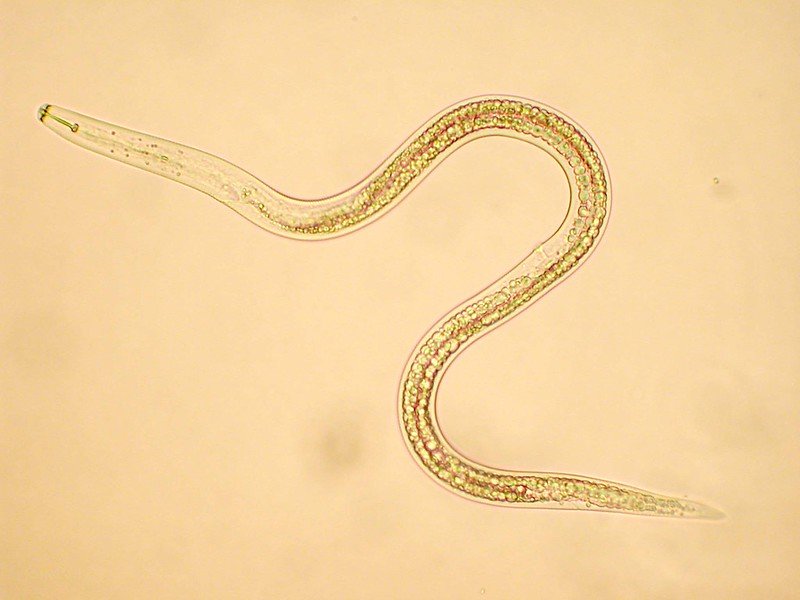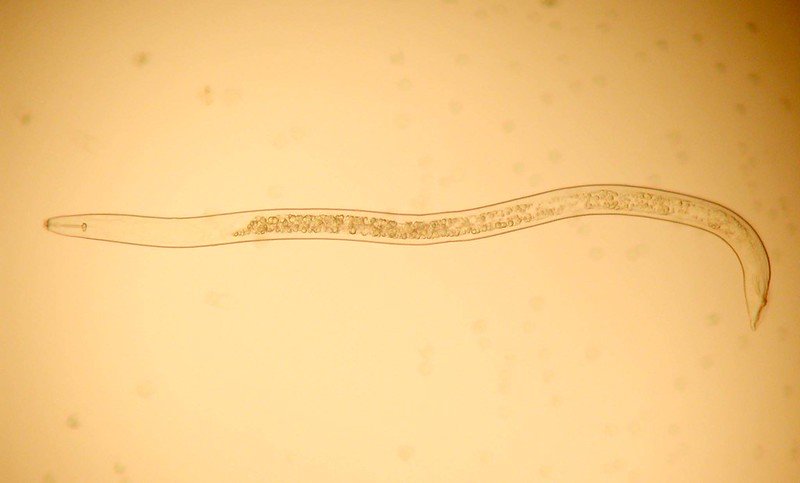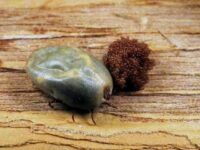Organic methods and biological pest control are environmentally friendly ways to decimate the population of certain animals or plants. It is a natural way to effectively get rid of pests in your yard – completely harmless to humans and pets. Nematodes of the genus Steinernema and Heterorhabditis are two such beneficial organisms that can easily be used in the garden to control a wide group of pests and to kill ticks.
What are nematodes?
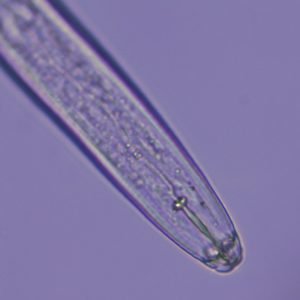
Nematodes are naturally occurring tiny roundworms. So far more than 20,000 different species have been described. Nematodes have successfully adapted to almost every terrestrial and aquatic ecosystem, including extreme habitats such as deep areas of the uppermost crust and the polar regions.
Nematodes have a typical worm-like shape, are long and round in cross-section. There is no segmentation.
The head of a roundworm has some tiny hairs or bristles that function as directional organs and a large muscular mouth with a pharynx (throat). The mouth is at the front and is often surrounded by processes that are used for feeding and groping.
The food of these tiny roundworms depends on the species and varies greatly. It ranges from bacteria and algae to fungi, carrion and fecal matter to a diverse range of live prey.
Types of nematodes
The following are the general types of nematodes.
- Bacteria-feeder nematodes eat bacteria.
- Fungi-feeder nematodes puncture the cell wall of fungi and suck out the internal contents.
- Predatory nematodes eat all types of nematodes and protozoa. They eat small organisms or stick to the cuticle of larger nematodes. They extract the prey’s internal body parts by scraping the cuticle.
- Omnivorous nematodes eat a wide range of organisms or may have a different diet at each life stage.
- Beneficial Nematodes attack pests such as snails, weevils, hair gnats, woodlice, mole crickets ticks, fleas, and many more.
What are beneficial nematodes?
A classic example of biological pest control are cats that are kept on farms to decimate mice and rats.
In biological pest control, specific soil-dwelling nematode species are used. They act as natural enemies and decimate the number of various pests in an environmentally friendly way.
The Beneficial Nematode species that are approved for biological pest control in gardens are the genus Steinernema and Heterorhabditis. Five types of nematode species are commonly used:
- Steinernema feltiae (SF)
- Steinernema carpocapsae (SC)
- Steinernema kraussei (SK)
- Heterohabditis bacteriophora (HB)
- Phasmarhabditis hermaphrodita (PH)
Do beneficial nematodes kill ticks?
The species Steinernema feltiae (SF) and Heterorhabditis bacteriophora (HB) are beneficial nematodes that kill ticks.
How to apply beneficial nematodes in gardens
Applying beneficial nematodes to lawn or yard is very easy, and requires only a little preparation before they are ready to be applied with a watering can or with a sprayer.
Beneficial nematodes are available in the form of different products including clay, dry granules, gels, and water-filled sponges or powdery solutions.
They come in different pack sizes with different amounts of nematodes, depending on the size of the intended application areas. Read the manufacturer’s instructions carefully before applying beneficial nematodes.
Mix the contents of the packet with a small amount of water to make a slurry, then add the rest of the water as instructed. Stir well and fill the mixture into the watering can or a sprayer and treat the affected areas.
Be sure about the selection of the product that contains a nematode species which is effective against ticks or the pest you want to control.
- No refrigeration required
- Ideal preventative treatment for tropical plants which are brought indoors after the outdoor gardening season is over, bee and beneficial safe
- We do not ship this product to the state of HI due to State regulations
- Sunlight exposure: Shade
Last update on 2025-11-12 / Affiliate links / Images from Amazon Product Advertising API
Tips for successfully applying beneficial nematodes
- Store the nematodes in the fridge at around 40°F and use them as soon as possible.
- Water the soil well before treatment.
- Apply when the soil temperature is 40°F or above.
- Nematodes don’t like bright light, sunlight kills them so spray early in the morning or evening.
- Do not apply in hot weather, otherwise, the nematodes will dry out. Ideally in cloudy weather or in the evening.
- After application, water and keep the soil moist for two to three weeks because nematodes need moist soil.
- For lasting success, repeat the treatment for two to three years.
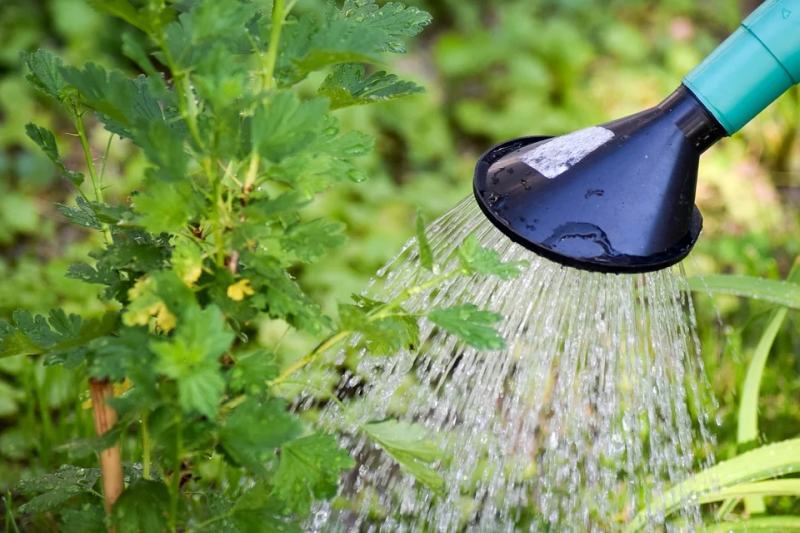
How do beneficial nematodes kill ticks or other pests?
Beneficial Nematodes are endoparasites, which means they live inside a host and either eat the host from within until the host dies or they remain inside the host in a symbiotic relationship without killing it.
The nematodes used in biological pest control kill their host. Some nematodes search actively for suitable hosts, while others wait for the insect/host to come to them.
When a host is found, they enter the pest through openings in the body. Inside the host’s body, they release a bacterium that is completely harmless to warm-blooded animals and humans but kills the host within a few days. In the host itself, the nematodes can multiply until the host is completely consumed. Then they leave the carcass and look for a new host. If there are no more host larvae, the nematodes die after a certain time.
Benefits of organic pest control in gardens
- Even though beneficial nematodes destroy insect pests, they are non-toxic and safe for people and pets.
- No safety equipment or masks are required during application.
- Can not be overdosed, because these nematodes have no adverse effects on plants, animals, and humans.
- Safe for beneficial bugs such as Ladybugs, Praying Mantis, Aphid Midges, Green Lacewings, Earthworms, …
- They are safe for pollinators, such as bees. They are also not harmful to groundwater.
- Foodplants that you grow on soil treated with biocontrol or organic pesticides will be healthier to consume as there will be no chemical pesticide residue that you intake via the food.
- Organic pest control helps in the betterment of soil in the long run.
- Natural pest control methods reduce carbon footprint and protect the environment for our children.
Biology and life cycle of beneficial nematodes
Beneficial nematodes attack a wide variety of garden pests. They are endoparasites of insects and arachnids. They cause no harmful effects on earthworms, plants, animals, and humans, so they are environmentally friendly.
The life cycle of beneficial nematodes includes the egg stage, four larval stages, and the adult stage. The infective form of the nematode is the third larval stage. They locate the susceptible hosts by detecting excretory products, carbon dioxide, and temperature changes. Their primary hosts are the insect larvae. Juvenile nematodes invade the insect hosts through their mouth, anus or breathing holes (spiracles). Heterorhabditis nematodes can also penetrate through the insect’s body wall. The nematodes carry Xenorhabdus sp. bacteria in their pharynx and intestine. As soon as the bacteria are introduced into the insect host, the death of the host usually occurs in 24-48 hours.
The bacteria break down the internal structure of the insect with the help of enzymes. The Steinernema sp. grows into adult males and females which mate within the insect’s body cavity.
Heterorhabditis sp. produces young through hermaphroditic females. The nematodes feed on the insect tissue that has been broken down by the bacteria. After they have matured to the third juvenile stage, the nematodes leave the remains of the insect body.
How are nematodes beneficial for organic pest control?
Beneficial nematodes have several advantages over chemical control.
- Nematodes have a wide range of hosts and can be used to control numerous insect pests.
- Beneficial Nematodes can be grown on artificial media. So, they can be used to make easily available and inexpensive products for pest control.
- They can tolerate most of the insecticides, fertilizers, and herbicides. The nematode juveniles remain alive for a time without nutrition while searching for a suitable host.
- Nematodes kill insect pests quickly within 24-48 hours, as compared to most other biological controls, which can take days or weeks to be effective.
- Many species of both Steinernema and Heterorhabditis have been tested for effectiveness against ticks with varying degrees of success. The most successful are now marketed under several brand names.
- Check the "Guide" under images to determine which nematodes you need
- ++Hb (Heterohabditis bacteriophora) ++Sc (Steinernema carpocapsae) ++Sf (Steinernema feltiae)
- Guaranteed Fresh and Alive!
- Check the "Pest Guide" under images to determine which nematodes you need
- Can be used indoors and outdoors
- Natural & Safe to use around Animal, Pets and Plants
- As long as they are not activated with water, they can be stored for 30 days in the refrigerator
- SLOW-RELEASE NEMATODES FOR EFFECTIVE PEST CONTROL – Ready-to-use granular formulation that provides continuous protection against fungus gnats, thrips, whiteflies, and other garden pests.
- EASY SHAKEABLE APPLICATION – No mixing required; simply shake the desired amount directly onto the affected area for hassle-free pest control.
- SAFE & NATURAL BIOLOGICAL SOLUTION – Non-toxic and environmentally friendly nematodes that target pests without harming beneficial insects, pets, or plants.
- VERSATILE USE FOR ALL GROWING ENVIRONMENTS – Ideal for greenhouses, hydroponic systems, gardens, indoor and outdoor potted plants, and even lawn spot treatments.
- LONG-LASTING & REAPPLICATION FOR BEST RESULTS – Apply again 10-14 days after the first use to effectively break the pest life cycle and prevent reinfestation.
- Can be stored unactivated for up to 30 days in the refrigerator (do not freeze).
- Rate: up to 6,200 square feet of soil area
- Can be used indoors and outdoors
- Easy to apply and can be use around humans and pets.
- Store unactivated nematodes for up to 30 days in the refrigerator
Last update on 2025-11-07 / Affiliate links / Images from Amazon Product Advertising API
Sources and more to read:
